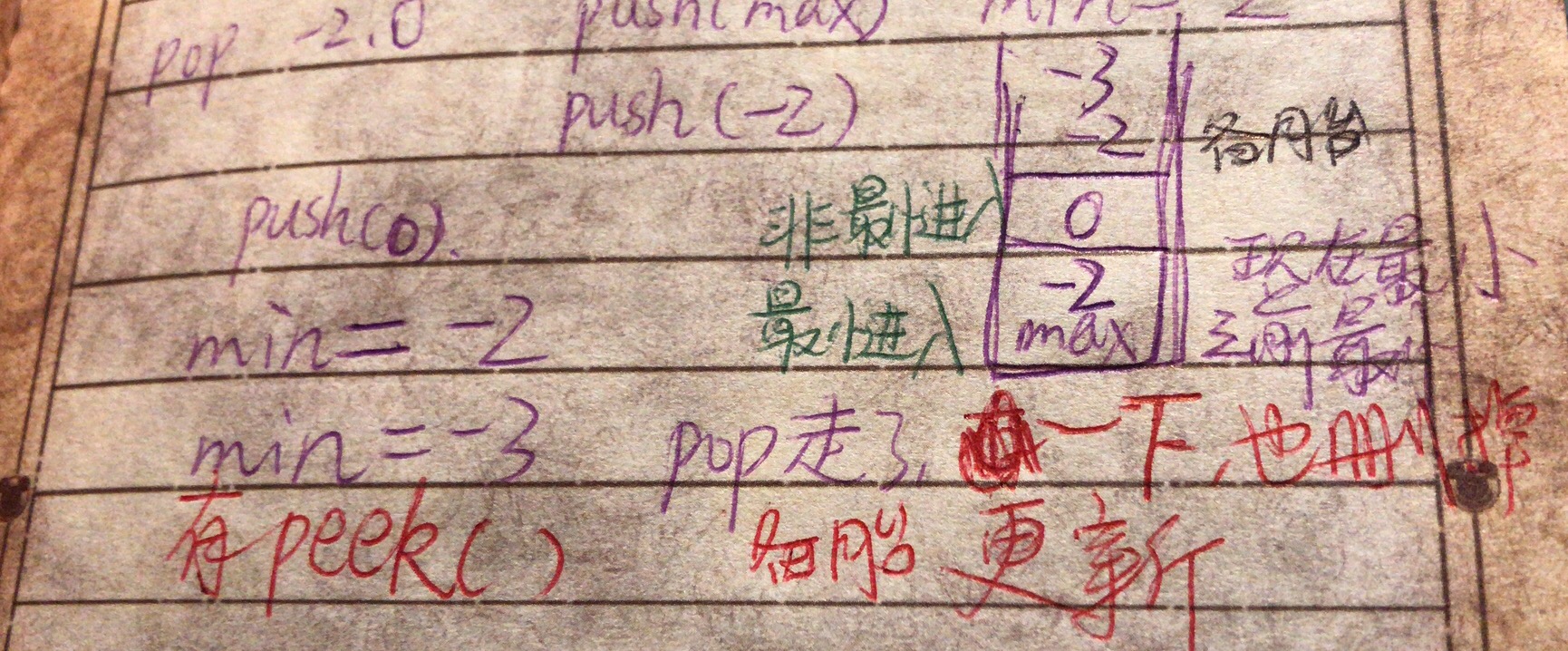[抄题]:
实现一个带有取最小值min方法的栈,min方法将返回当前栈中的最小值。
你实现的栈将支持push,pop 和 min 操作,所有操作要求都在O(1)时间内完成。
[思维问题]:
想不到,脑洞不够大
[一句话思路]:
用一个minstack来辅助实现
[输入量]:空: 正常情况:特大:特小:程序里处理到的特殊情况:异常情况(不合法不合理的输入):
[画图]:
[一刷]:
- 主函数中,数据结构为类+名 类是Stack<Integer>
- minStack.empty() == true 或者isempty都可以
- pop分为两种情况:二者peek(不是peak)相等的、不相等的; 方法加点来用
[二刷]:
- push可能有空的情况,要注意
[总结]:top只是看一看,peek也只是看一看。所以top里面包含peek
[复杂度]:Time complexity: O(1) Space complexity: O(n)
[英文数据结构,为什么不用别的数据结构]:
[其他解法]:
[Follow Up]:
[题目变变变]:

public class MinStack { private Stack<Integer> stack; private Stack<Integer> minStack; public MinStack() { // do intialization if necessary stack = new Stack<Integer>(); minStack = new Stack<Integer>(); } /* * @param number: An integer * @return: nothing */ public void push(int number) { // write your code here stack.push(number); if (minStack.isEmpty()) { minStack.push(number); } else { if (number <= minStack.peek()) { minStack.push(number); } } } /* * @return: An integer */ public int pop() { // write your code here if (stack.peek().equals(minStack.peek())) { minStack.pop(); } return stack.pop(); } /* * @return: An integer */ public int min() { // write your code here return minStack.peek(); } }

class MinStack { Stack<Integer> stack = new Stack<Integer>(); Stack<Integer> minStack = new Stack<Integer>(); /** initialize your data structure here. */ public MinStack() { Stack<Integer> stack = new Stack<Integer>(); Stack<Integer> minStack = new Stack<Integer>(); } public void push(int x) { //stack: push stack.push(x);//s:2 //min stack:push when it's null or minimum if (minStack.isEmpty()) { minStack.push(x); } else if (x <= minStack.peek()) { minStack.push(x); //ms:2 } } public void pop() { //stack:get, min stack: pop when it's mean if (minStack.peek().equals(stack.peek())) { minStack.pop(); //both 2, ms pop 2 } stack.pop(); //s pop 2 } public int top() { return stack.peek(); //return s pop 2 } public int getMin() { return minStack.peek(); //return ms pop 2 } } /** * Your MinStack object will be instantiated and called as such: * MinStack obj = new MinStack(); * obj.push(x); * obj.pop(); * int param_3 = obj.top(); * int param_4 = obj.getMin(); */
解法2: 只用1个stack
[抄题]:
[暴力解法]:
时间分析:
空间分析:
[奇葩输出条件]:
[奇葩corner case]:
[思维问题]:
不懂题目意思:设计新的数据结构。原生的stack中本来就有push pop peek方法
[一句话思路]:
刷新最小值时 stack中存2个 留着最小值备胎。否则只存1个 要走就走,下面一层还是最小值。
[输入量]:空: 正常情况:特大:特小:程序里处理到的特殊情况:异常情况(不合法不合理的输入):
[画图]:

[一刷]:
- pop一个元素之后把备胎也pop出去,以便于下次的pop, 不留痕迹
- class中声明后,MinStack()方法用于建立新的数据类型(真心是没话可说了)
[二刷]:
[三刷]:
[四刷]:
[五刷]:
[五分钟肉眼debug的结果]:
[总结]:
备胎需要斩草除根
[复杂度]:Time complexity: O(1) Space complexity: O(n)
都是立存立取的
[英文数据结构或算法,为什么不用别的数据结构或算法]:
原生的stack中本来就有push pop peek方法
[关键模板化代码]:
[其他解法]:
2个stack
[Follow Up]:
[LC给出的题目变变变]:
716. Max Stack 2个stack
[代码风格] :
